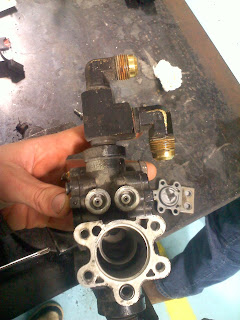This week while working on a tractor that was getting coolant into the number 1 cylinder, I had discover that there was a gap between the cylinder liner and the block. The cylinder liner is supposes to be a .004" interferance fit and there was a .003" gap in a couple spots. Its my suspicion that the block is cracked around the liner and allowing coolant up through the liner. I came to this conclusion because the cylinder head has no cracks and passed a pressure test so that means it has to be in the bottom end. The deck on the block is within specs for being level.
Wednesday, November 27, 2013
Tuesday, November 19, 2013
ABS modulator valve
Monday, November 18, 2013
FQ Hans
This week I put some fittings on DOT air lines used on trucks. These fittings use a feral to seal them when the two ends are screwed together
Monday, November 11, 2013
FQ Hans
This week I adjusted a wheel bearing on the kenworth in the shop. I used the TMC procedure to adjust the bearing. The procedure for this is to 1. Tighten the inner nut to 200 ft lbs to seat the bearing. Then 2. Back off the inner nut one full turn. Next 3. Torque the inner nut to 50 ft lbs. Then 4. Back the inner nut off 1/4 turn. Then you can install the washer and the outer nut. Finally you torque down the outer nut. The torque of the outer nut is dependent on whether it is a drive or steer axle, how many threads per inch it has and what type of washer it uses. In this case the finally torque was 300-400 ft lbs. Once that is done you can place a dial indicator from the wheel hub to the axle nut and move the hub back and forth to measure endplay. Endplay should be between. 001-.005 of an inch. If you have a reading of zero, the adjustment needs to be redone because then you don't actually know how much preload is on the bearing.
Monday, November 4, 2013
FQ Hans
This week I was testing on my truck why the turn signals on the right side would blink faster than the turn signals on the left. It was pretty obvious that the relay for the turn signal flashers was going bad. I had also found out that the way the bulb for the turn signals in the tail lights goes in makes a difference. The bulb for the blinker is also a bulb for the tail lights and brake lights. I had put a bulb in the wrong way on one of them so you could see the turn signal light when the tail lights where. So after I saw that was going on I tested to make sure I had proper voltage and the I looked at the bulb and realized the filaments were different sizes. So I switched the bulb around and it worked fine again.
Week = 51 , total = 260












